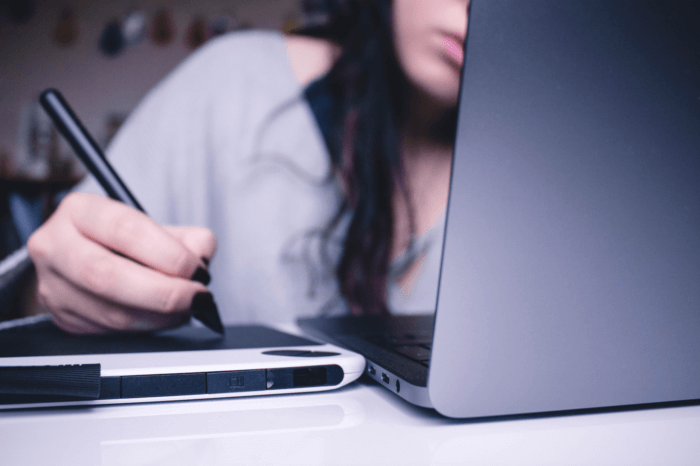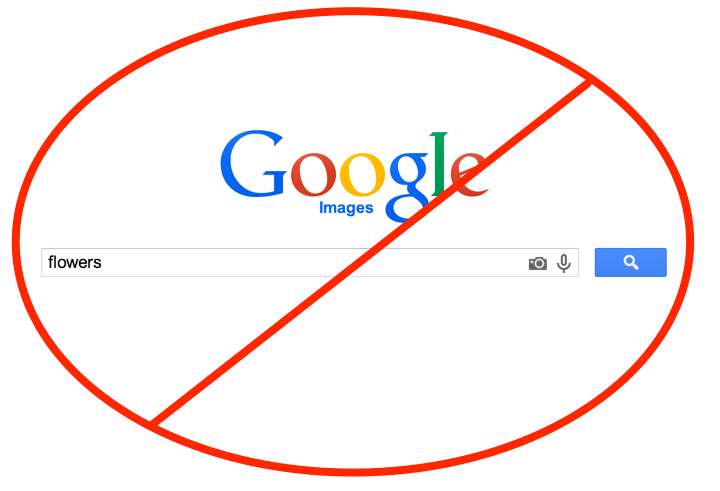Do Digital Copyright Laws Go Agains the Original Purpose of Copyright Laws
Everyone has heard the adage, "A picture is worth a thousand words."
Pictures are also worth a crap load of money to the person suing you for copyright infringement. Today we're talking about online images copyright and fair use laws (in the United States). Pay close attention folks; this could save you a lot of Benjamins down the road.

All About Online Images Copyright
As content creators, we understand the importance of images. Using images to break up a wordy post can make it appear less daunting, and the right image can drive your message home. At a more juvenile level, images make reading way more fun. The average two-year-old has no idea how to read, but if you give him/her a stack of picture books they are entertained for hours. I'm of the belief that we never grow out of loving pictures – and while it's tempting to Google the exact image we have in mind (I'm guilty of it!), it's critical that we don't get sloppy and neglect copyright laws.
What is Copyright?
We see the little © all over the place, but what does it mean and how did it get there? To get a comprehensive and accurate understanding of copyright, I went to the most official source I could think of – the United States Copyright Office.
Copyright, a form of intellectual property law, protects original works of authorship including literary, dramatic, musical, and artistic works, such as poetry, novels, movies, songs, computer software, and architecture(source: US Copyright Office).
Now that we have a pretty explicit description of what copyright is, it's time to address when copyright protects a piece of work.
Copyright attaches the second a piece of original work is created and fixed. This applies to both published and unpublished works. Copyright protections are in effect the moment you write a blog post, snap a photo, or create a video. The moment you upload a selfie, you're protected by copyright. Even if you never publish that selfie on Instagram because your face looks so splotchy that a filter can't fix it – that image is still protected by copyright law.
You may be asking, "What's the deal with the ©?". Copyright is an automatic right and registering a piece of work with the US Copyright Office is voluntary. The automatic nature of the law gives you the freedom to place a © on any of your work. However, if you choose to bring a lawsuit for infringement, you will have to register your work.
Exclusive Rights of Copyright
A serious perk of copyright is that it gives the creator of an original work complete control over its use and distribution. The Copyright Act grants five rights to a copyright owner:
- The right to reproduce the copyrighted work.
- The right to prepare derivative works based upon the work.
- The right to distribute copies of the work to the public.
- The right to perform the copyrighted work publicly.
- The right to display the copyrighted work publicly.

When can you use someone else's image?
The rule of thumb is that you must receive authorization from the creator in order to use his/her image (you'd be smart to get this in writing). Does this mean that every single one of the billions of pictures on the internet is either authorized by the creator or in violation of online images copyright? The answer is no – and this is where fair use comes into play.

Source: Sebastian Pichler via Unsplash
All About Fair Use
Fair use is an exception and limitation to the rights of exclusivity that are granted by copyright to the creator of a piece of work. In the US, fair use allows for limited use of copyrighted material without authorization from the author of the creative work. The purpose of fair use is to provide limited use if it benefits the public.
Don't get too excited! Fair use isn't a green light to use any image under the sun – like everything in life, there are rules, and this isn't one that is meant to be broken or exploited. After reading Section 107 of the Copyright Act, I not only gained an enormous respect for law students, but I also learned the limits of fair use.
The fair use of a copyrighted work, including such use by reproduction in copies or phonorecords or by any other means specified by that section, for purposes such as criticism, comment, news reporting, teaching (including multiple copies for classroom use), scholarship, or research, is not an infringement of copyright (source: 17 USC Section 107).
As you can guess, fair use isn't a black or white sort of thing. If you aren't a lawyer with a very in-depth understanding of copyright law and online images copyrights, there can be a lot of confusion as to what is considered beneficial to the public. To help clarify things, four factors determine whether the use of an image is considered "fair":
- The purpose of use: educational, nonprofit, scholarly, reporting, reviewing, or research
- The nature of use:fact-based or public content (courts are usually more protective of creative works)
- The amount and substantiality used:using only a small piece of the image, using only a small thumbnail/low-resolution version of the image
- The market effect: you could not have purchased or licensed the copyrighted work
As you can imagine, using a low-resolution image is probably not the ideal situation if your goal is to create a professional-looking piece of content. On the flip side, if you're doing a movie or book review, it's nice to know that inserting a picture of the film or book won't get you in trouble.
These fair trade rules are pretty nitty-gritty. If you're interested in learning a more about what is considered fair use, check out this article from Columbia University. You can also familiarize yourself with some specific internet cases. Reading about the rulings should give you a better understanding.

Source: Josefa nDiaz via Unsplash
How does this affect content creators/curators?
The answer is pretty simple: As content creators and curators, we have a responsibility to follow these rules for online images copyrights because, at the end of the day, it's on us if we mess up. I assure you the company you're guest blogging for will be very unhappy if they receive this in their inbox:

Just to be clear, in the case above the demand for the single image misuse was $8,000! Now before you start getting all stressed out by this excerpt of a cease and desist email, I have really good news for you: this email can be easily avoided.
Safe Options For Online Images Copyright
It should be pretty clear by now that fair use laws are pretty complicated. Heck, if you've gotten this far in the post, past all the legal jargon, I commend you! While you can choose to do a ton of research, familiarize yourself with the rules, and continue to use Google Image search to source images, I personally think this is a pretty risky choice. It only takes one slip up to get slammed with a very unwelcomed cease and desist email.

Create Your Own Images
What do I recommend? Elect to either create your own images using graphic design tools like OmniGraffle, Indesign, or Photoshop. If you don't have an ounce of design skill in your body, try using a tool that aims to make design simple for everyone like Canva, Snappa, or Pablo. If the cost of design software is holding you up, try testing out Vectr, a free graphics software, or Gimp, a free and open-source image editor.
Download Free Stock Photos
If you use a TON of images, or you don't have the budget to pay for images, you can always download free stock photos. Here is a shortlist of some of my favorite free stock image sites:
- StockSnap.io : StockSnap has hundreds of beautiful high-resolution photos that are free from copyright restrictions. They add new photos every week and can subscribe to have them sent to your inbox.
- Unsplash: Unsplash is built by a community of over 41,000 photographers who aim to inspire. This site has over 200,000 images that companies including Slack, WordPress, Squarespace, and Apple have used.
- Flickr:Flickr is probably the most popular resource for free stock images. They have a combination of professional photos and amateur photos, so you may have to do some digging to find what you want. While a lot of the pictures are fair game on Flickr, you have to confirm that you follow the rules of the creative commons license they have selected.
- Stock.Xchng:With a robust search engine, this is one of my preferred places to "shop" for free images. Stock.Xchng is owned by iStock, so the first row of images are often paid images – but the pictures that follow are entirely free!
- Pixabay:If you're after high-quality images, Pixabay is where it's at. Also, you don't have to create an account to download a picture. Just click "download," and you're set to go.

Purchase Stock Photos
The perk of choosing paid over free is that you'll have a much easier time finding what you're looking for. Here are a few of my favorite resources:
- Getty Images: With one of the largest image databases (over 80 million still images and illustrations), you're guaranteed to find what you are looking for. The downside: the images are often expensive, and Getty is one of the biggest purveyors of cease and desist emails (so make sure you pay for them!).
- Fotolia:Fotolia's subscription service can save you a lot of money if you plan on using images often.
- iStock: If you have a particular image in mind, iStock's awesome search box will help you quickly get what you need.
- Cutcaster: If you aren't a fan of subscription services, Cutcaster gives you the opportunity to pay as you go. Also, their photos are extremely organized, making finding what you want a pain-free process.
If you are going to take one thing away from this post, make it this: If even an iota of doubt exists as to whether or not an image is subject to copyright, assume that it is. Either consult an expert in copyright law, or take the safe bet and visit one of the stock photo sites I've listed above. I can not express how expensive of a mistake using a copyrighted image is. The good news – it's a mistake that can easily be averted!
If you have any questions, please leave them in the comment section below. I'll do my very best to answer them.
This article was originally published on January 16, 2014, and has since been updated.
macqueenonocclacter46.blogspot.com
Source: https://www.rivaliq.com/blog/guide-copyright-fair-use-laws-online-images/